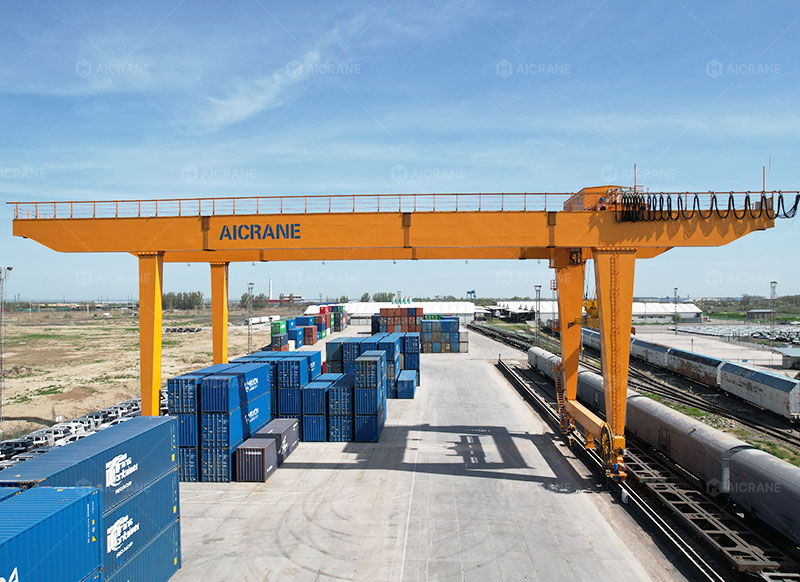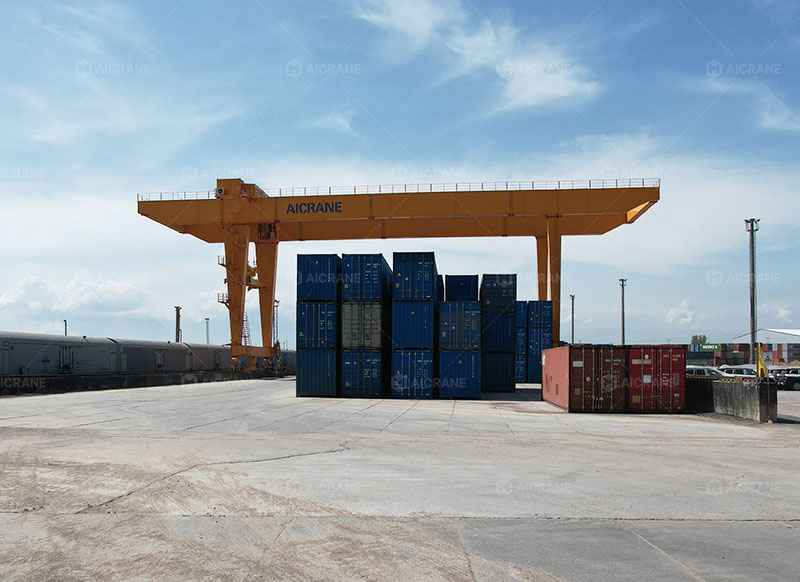Rail-mounted gantry (RMG) cranes are pivotal in heavy-duty material handling, especially in ports, container yards, and large industrial operations. Their ability to lift, move, and precisely place massive loads makes them indispensable in modern logistics and industrial processes. Central to their functionality is the lifting mechanism, which directly affects efficiency, safety, and reliability. Understanding how this mechanism works is essential for operators, maintenance teams, and buyers who want to optimize performance or select the right crane for their application.

What is a Rail-Mounted Gantry Crane?
A rail-mounted gantry crane is a type of overhead crane mounted on rails, typically running parallel to container rows or along industrial sites. The crane spans a set width and can traverse the length of the yard or production area, lifting loads with a hoisting system that moves along the bridge. Compared to rubber-tyred gantry cranes, rail mounted gantry cranes offer greater stability, higher lifting capacities, and precise movement along the tracks.
RMG cranes are widely used for container handling, steel coil movement, and heavy machinery transport. Their lifting mechanism is the heart of their operation, enabling them to safely handle massive loads with speed and accuracy.
Components of the Lifting Mechanism
The lifting mechanism of an RMG crane is a sophisticated assembly of mechanical, electrical, and sometimes hydraulic components. Its main purpose is to lift and lower loads smoothly while maintaining stability. Key components include:
1. Hoist
The hoist is the primary lifting component. It converts electrical or mechanical power into vertical movement. There are two main types of hoists used in RMG cranes:
-
Wire Rope Hoist: This is the most common type. Wire ropes wound around a drum lift the load. Wire rope hoists are durable, capable of handling very heavy loads, and suitable for long lifting heights.
-
Chain Hoist: Less common in RMG container cranes but sometimes used for lighter applications. Chain hoists are compact and simple but less suitable for very high or heavy lifting.
Modern RMG cranes often incorporate double hoist systems for tandem lifting or redundancy, enabling the crane to lift very heavy loads safely.
2. Trolley
The trolley is the platform on which the hoist is mounted. It moves horizontally along the bridge of the crane, positioning the hoist precisely over the load. The trolley allows the crane to lift and place containers, steel coils, or heavy machinery with exact placement, improving efficiency and reducing the risk of accidents.
3. Wire Rope and Drum System
For wire rope hoists, the drum and wire rope system is crucial. The drum winds the rope in or out, raising or lowering the hook. The system includes brakes and tensioners to prevent uncontrolled descent and ensure smooth, controlled lifting. Wire rope quality, drum design, and groove alignment are critical for longevity and safety.
4. Hook and Hook Block
The hook block is the component that connects the load to the lifting mechanism. Hooks are often fitted with safety latches to prevent accidental load release. In container handling applications, a spreader attaches to the hook block to lock onto the container’s corner castings, providing a secure grip during lifting and placement.
5. Motor and Gearbox
Electric motors drive the lifting operation, either directly or through a gearbox. The gearbox reduces motor speed while increasing torque, allowing the overhead gantry crane to lift extremely heavy loads with controlled precision. Modern RMG cranes use variable frequency drives (VFDs) for smooth acceleration and deceleration, reducing mechanical stress on the lifting components.
6. Braking System
Brakes are essential to prevent uncontrolled descent of heavy loads. Most RMG cranes use a combination of mechanical and electromagnetic brakes, providing redundancy and ensuring safety even in case of power failure. Properly maintained brakes are critical to crane safety.

How the Lifting Mechanism Works
Understanding the operation of an RMG crane’s lifting mechanism helps illustrate its complexity and precision:
-
Positioning the Crane: The crane operator moves the RMG along its rails to align the hoist over the target load. Modern RMG cranes may be operated via remote control or automated systems, improving efficiency and reducing operator fatigue.
-
Lowering the Hook: The hoist lowers the hook or spreader to engage the load. Sensors and cameras may assist in precise positioning.
-
Engaging the Load: The hook or spreader attaches securely to the load. For containers, twist locks on the spreader ensure a tight grip.
-
Lifting the Load: The hoist drum rotates, winding the wire rope and raising the load. The gearbox and motor provide the necessary torque, while the braking system ensures controlled motion.
-
Moving Horizontally: With the load lifted, the trolley moves along the bridge to the desired placement point. The load remains stable due to the crane’s structural rigidity and precise controls.
-
Lowering and Placement: The hoist lowers the load smoothly. Sensors and automation systems prevent abrupt movements, reducing the risk of load swing or impact.
-
Release: Once in position, the hook or spreader releases the load, completing the operation.
Safety and Efficiency Features
RMG cranes incorporate several features to enhance safety and lifting efficiency:
-
Load Monitoring Systems: These sensors measure the weight of the load and prevent lifting beyond rated capacity.
-
Anti-Sway Mechanisms: Reduce lateral swinging of loads during movement.
-
Limit Switches: Prevent over-travel of hoists and trolleys.
-
Automation and Remote Control: Enhance operational accuracy and reduce human error.
-
Redundant Braking Systems: Ensure safe load handling even in case of mechanical or electrical failure.
Maintenance Considerations
The lifting mechanism of an RMG port gantry crane requires regular inspection and maintenance to ensure safety and longevity:
-
Wire Rope Inspection: Regularly check for wear, corrosion, or fraying.
-
Lubrication: Keep gears, drums, and wire ropes properly lubricated to reduce wear.
-
Brake Testing: Test mechanical and electromagnetic brakes periodically.
-
Motor and Gearbox Checks: Ensure proper operation and monitor for overheating or unusual noise.
-
Hook and Spreader Inspection: Check for deformation or cracks.
Proper maintenance extends the life of the lifting mechanism and reduces downtime, ultimately saving operational costs.
Conclusion
The lifting mechanism of a rail-mounted gantry crane is a sophisticated integration of mechanical, electrical, and safety components designed to lift and move heavy loads with precision and reliability. From the hoist and trolley to the wire ropes, drum, and braking system, every component plays a critical role in ensuring safe, efficient operation. Understanding this mechanism is not only essential for operators and maintenance teams but also for decision-makers evaluating crane options for industrial or port applications. With proper operation, maintenance, and attention to safety features, RMG cranes provide unparalleled lifting capabilities, supporting some of the most demanding material handling tasks in modern logistics and industrial operations.